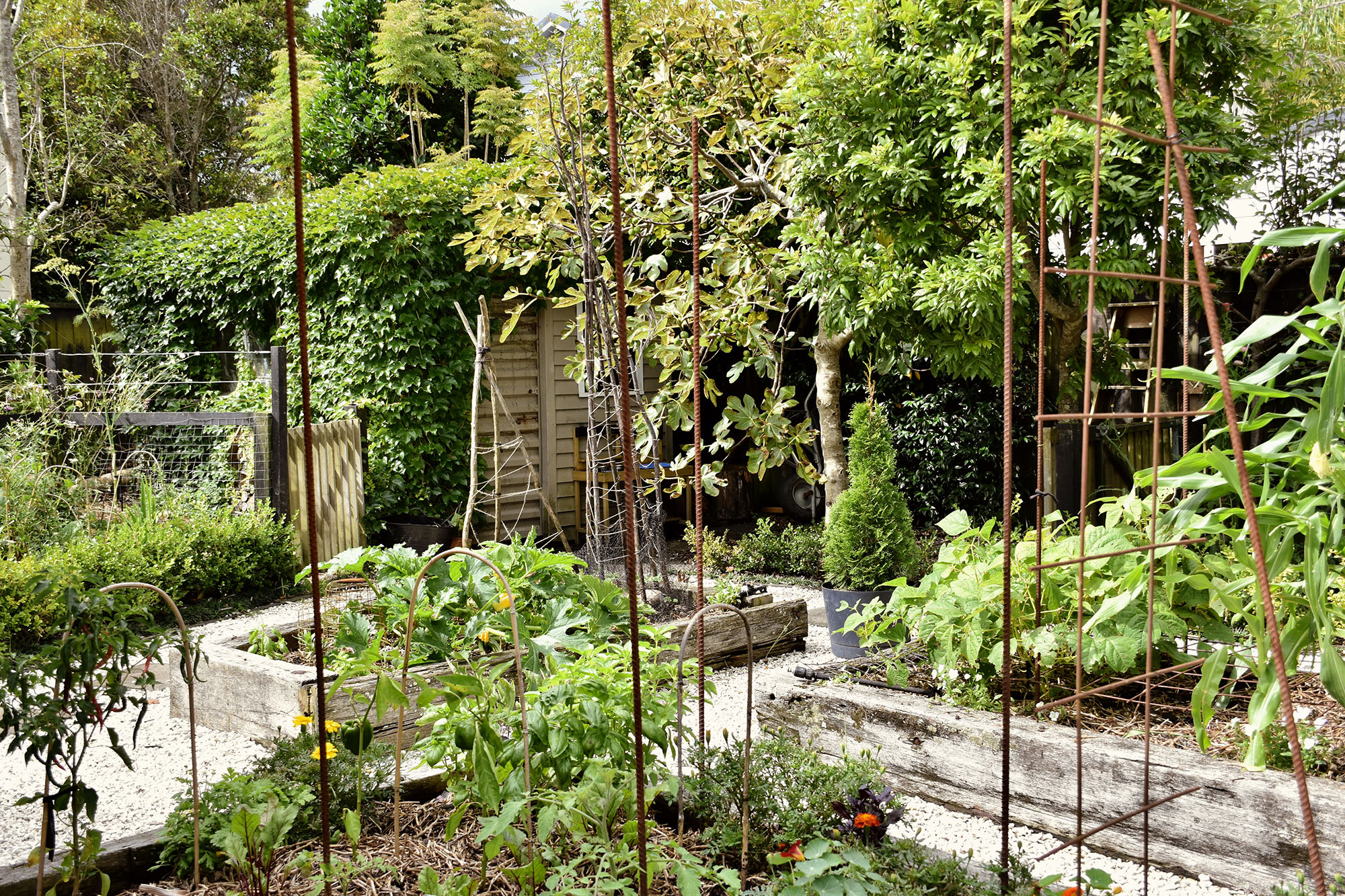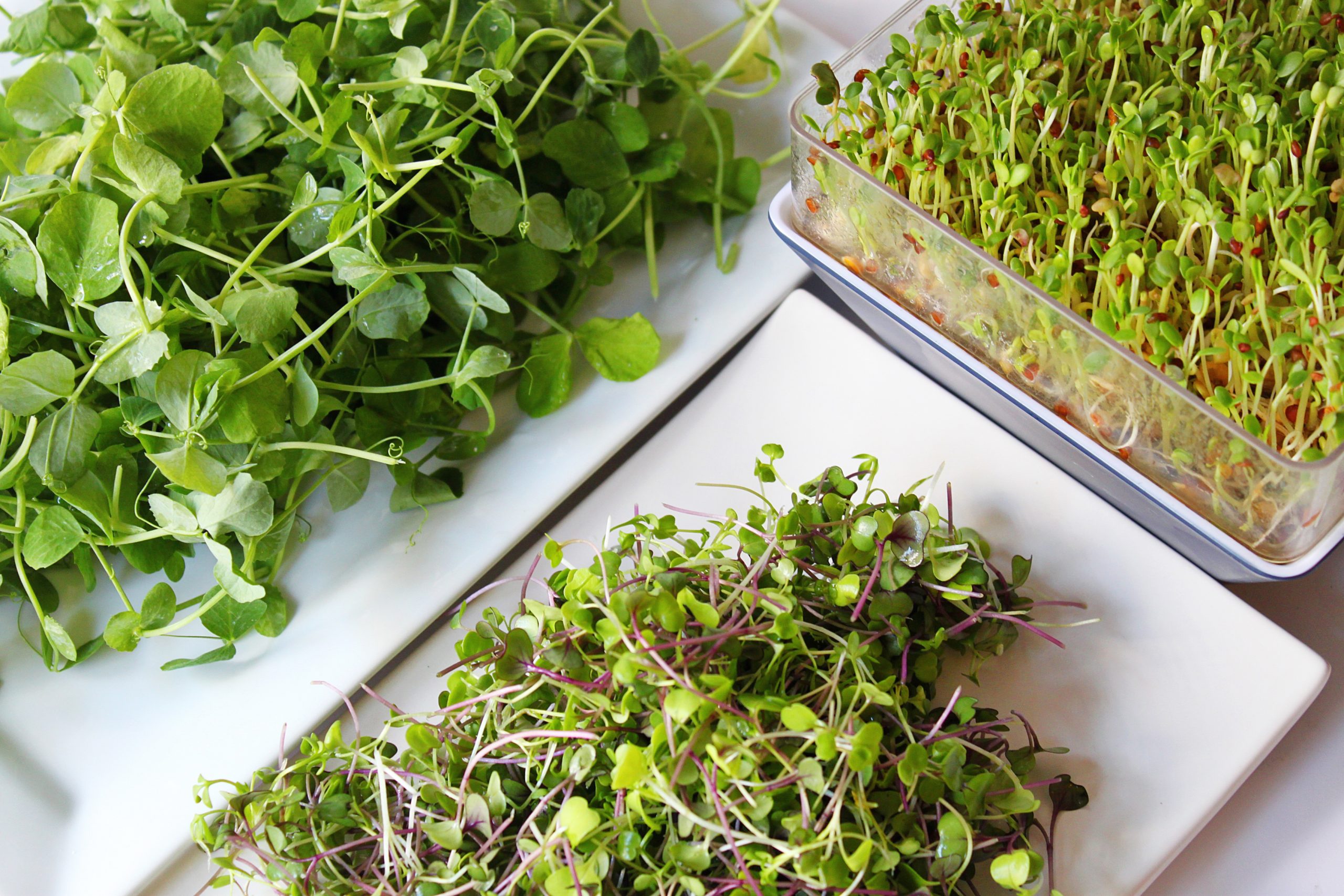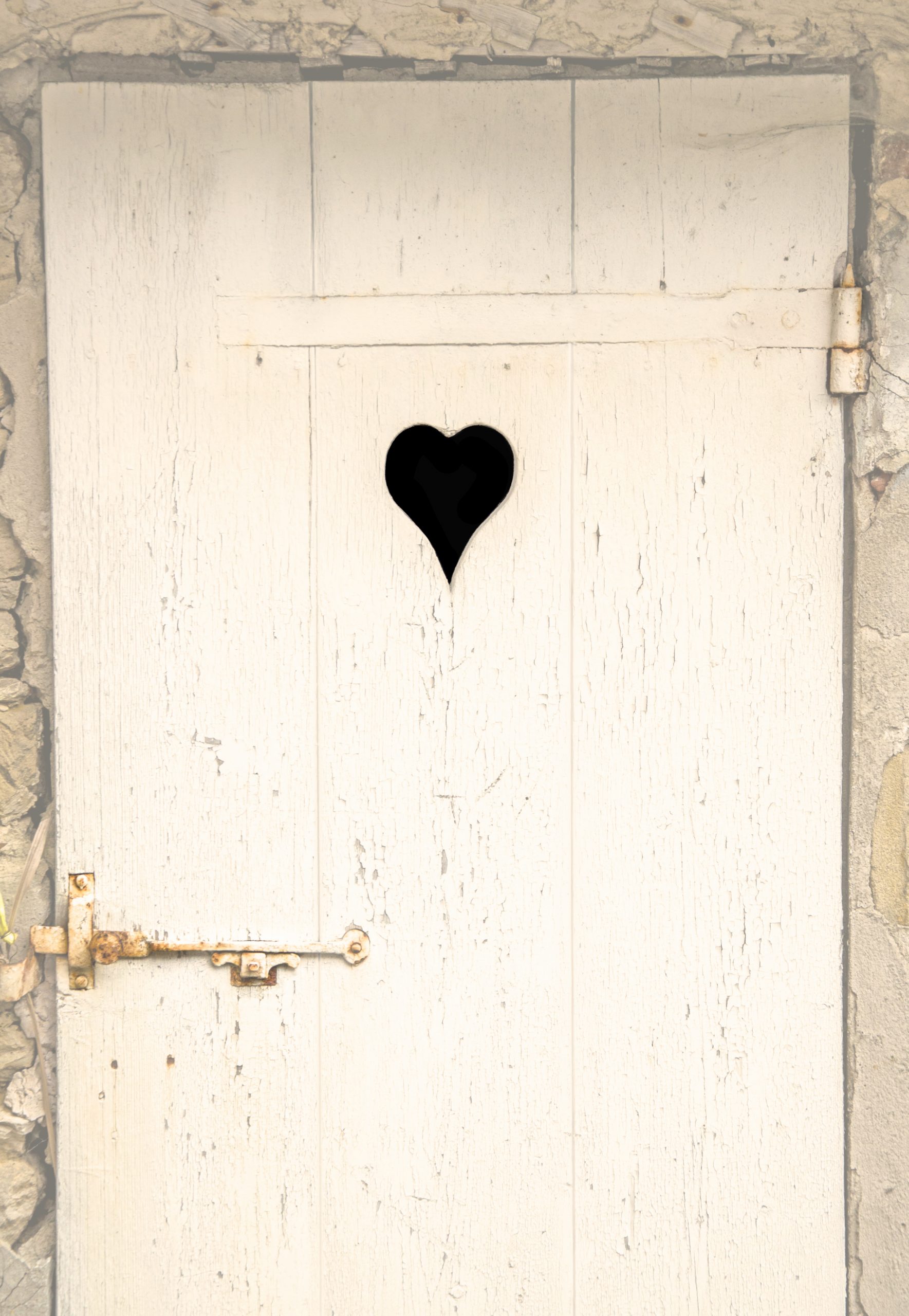Words by Jane Mahoney and Sophie Bannan
Phoebe and Dave Atkinson’s gardening practice is deeply entwined with their family and community. Twelve years on from purchasing their Forrest Hill property, the garden and their gardening ideology have expanded to include a seedling stand as well as the community garden. Their two beautiful children are involved in every aspect.
For as long as Phoebe can remember, she’s been drawn to gardens. If she ever came across some kind of structured productive space, she gravitated there. Her early years were spent on a classic quarter-acre (1012-square metre) section in semi-rural Bethlehem, Tauranga, with mature vegetation, chickens and a vegetable garden to feed the family. With three older siblings and a small-town locale, Phoebe was a ‘free-range kid’ whose patch extended beyond the fence to exploring the nearby valley.
Later, when Phoebe’s family moved between Auckland and Wellington, she saw her parents landscape a couple of different gardens to meet their changing needs. This gave her an appreciation of the intentionality of gardening: she realised that plants don’t just happen around you. The understanding that your garden could be purposefully created has been central to her own gardening journey.

When she finished high school, Phoebe found herself undecided about her next move. She had enjoyed working for a florist while at school, and her parents were keen for her to pursue what she loved, so Phoebe enrolled in Unitec’s Sustainable Horticulture programme. The course gave her hands-on skills and confidence in gardening, but at that time she didn’t see a future in horticulture beyond working in a garden centre. She transferred to a town-planning degree at the University of Auckland, bringing her expanding horticultural knowledge with her, and also began digging up lawns at her student flats to plant productive gardens.
The pōhutukawa tree in Dave’s childhood garden extends over three properties. It’s the kind of tree that inspires passing arborists to knock on the door and request a closer look. Dave and his three older siblings grew up in the branches of this magnificent tree and gorged themselves on fruit from the orchard of their Takapuna home. As a young man Dave was more interested in skating than gardening, but as a designer he likes to create spaces, and when he met Phoebe their interests merged.
Phoebe and Dave bought their Forrest Hill property – a classic suburban bungalow with a sparse, grassed section – as a home for their future family.

Their desire for children unfolded into the ordeal of infertility, a process heavy with the grief of facing a future they could not control. Their garden became a mechanism for healing as they got stuck into a project they hoped would one day be enjoyed by their children. The garden was a hopeful space for them, pulling them forward through the seasons, rewarding them with growth, and connecting them with a like-minded gardening community.
Deciding to go down the path of adoption, Phoebe and Dave embarked on a year-long process of workshops and social-worker visits, all the while pinching themselves that maybe their future would hold children after all.
Then one day they received a call from their social worker – a baby boy had just been born, and his birth mother had chosen Phoebe and Dave to be his parents. The call came on a Monday, and the rest of the week was a whirlwind. Friends rallied around, Phoebe quit her job, and by Friday they were home with Harley, learning to be a family.

A few years later baby Kyla joined them, and their family is now complete.
Both adoptions are open, so Phoebe and Dave’s family tree is grafted together, with many branches wrapped around them and their children.
It wasn’t the biological family Phoebe and Dave had set out to create their garden for, but the adventure taught them that life can take you in surprising directions that are every bit as beautiful and rewarding as the path you had planned. It is a blessing they don’t take for granted.
Harley and Kyla have grown up in the garden. Three- year-old Kyla toddles around the garden in her yellow gummies, observing monarch butterflies, cuddling the chooks, and eating raspberries straight from the bush. She watches intently as Phoebe plants seedlings in the raised beds, letting Kyla water them in with her pail – and gives the dogs a drench for good measure!
Seven- year-old Harley is gentle, observant and hands-on in every aspect of the garden, rewarding Phoebe’s incredible patience for getting her children involved. Both are confident and gain palpable joy from making real contributions. Harley feeds the chooks and collects eggs, and can often be found sporting his beekeeping suit or with a cordless drill in hand.
With the home garden brimming with trees, vegetables, flowers, chickens and children, Phoebe and Dave began work on setting up the community garden. The project began with a free seedling stand on the street outside their house, to which people in the neighbourhood began adding. A bare patch of council reserve next to the local kindy caught their eye and, after a long process of council applications and community consultation, permission was granted and Grow Forrest Hill became a reality.
That Phoebe and Dave find the energy to manage the community garden on top of their full lives is reflective of their approach to both gardening and life: the more you give, the more your capacity for giving grows.

About the garden
The first thing Phoebe and Dave did when they bought their place was plant trees: native tītoki, puka, manatu (ribbonwood), nīkau, tī kōuka (cabbage trees) and mānuka, and a small orchard at the rear of the house. They got stuck into landscaping straight away, but not without a plan.
As a starting point, they recognised that their section lent itself to having several different zones – the house is in the middle with space at the front, at the sides and at the back. Phoebe knew she wanted an orchard with chickens, a vegetable garden, classic flat lawn for the kids to play on, and an entertaining space with an outdoor fire.
Gardening in a low-lying valley with heavy clay soil certainly has its challenges. In the early stages a lot of the trees and planting struggled, and some died. The solution has been a long process of building up the soil and finding the right spots for the right plants. They spent years observing other Auckland gardens, saving pages from magazines, and taking note of council planting of natives in public spaces. Many of the landscaping ideas and plant combinations they saw have been directly replicated in their own plan. That’s always their advice to people who don’t know where to start – open your eyes up to public spaces, look at what they’ve planted and what’s thriving, take note of the details, take photos of things you like.
While they have brought complementary skills to the project – Dave the landscaper and Phoebe the gardener – tensions do sometimes arise when their approaches clash. Phoebe is a self-confessed hoarder, always on the lookout for new ideas and materials that could be put to use, making decisions as she goes, and approaching the garden as an evolving project.
Whereas Dave, with his design background and aesthetic, likes to work to a plan.
For him there are always thousands of options, so a plan is the materialisation of intentional decisions, of ideas narrowed down to what will best fit their purpose.
The front section of the property is planted primarily with natives, with lawn and an entertaining area. Set on a spacious wooden deck extending from the house, a large dining table, sheltered by a ceiling of grapevines, is the social hub. An adjacent outdoor fire provides warmth and ambient lighting for late- night dinner parties, and Dave’s prized skate ramp descends from the back of the deck.
The garden at the rear of the house is in two parts. On one side is Phoebe’s structured, tidy potager garden, and the other side is wild, lovely chaos. Phoebe has always been drawn to the formal potager-style vegetable garden, remembering the raised beds and white chip of a garden she visited as a child with her mum.
Ngā Kaupeka’s raised beds are edged with massive sleepers salvaged from the Seafarers’ Building demolition site. The handsome white chip paths double as mud control for the low- lying bog- prone section. Behind the vegetable garden is a glasshouse, built by Dave using recycled window frames.
A flower bed – one of Phoebe’s non- negotiables in the garden plan – separates the meticulous, productive vegetable garden from the orchard, which is the perfect kind of chaotic, with compost bins, chooks, a bug hotel (built by Harley) and wildflowers under fruit trees. This is not just the space for the messy work of an extensive composting operation, but is an un-precious space for Harley and Kyla to do anything they like – from making mud pies to building huts and climbing trees.

Grow Forrest Hill
At inductions for new members, Dave reiterates that Forrest Hill Community Garden is not about the plants and produce, it’s about doing something together, about learning, and about connecting with one another.
Gardening is a great leveller. No matter what stage of life you’re at, when you come together and garden side-by-side you are all on the same page. It’s a beautiful catalyst for creating community because the focus is always on the task at hand, and the connection is an inevitable by-product.
The idea for the community garden surfaced in about 2019 when Harley started kindy. Phoebe and Dave had always been keen on the concept, but it was a chance conversation with kindergarten staff that was the lightbulb moment for Phoebe. She came home and told Dave about the nearby council space, he googled ‘how to start a community garden’, and so the project began.
Nothing about the process was straightforward, however. Dave enthusiastically describes it as a complicated, time-consuming, obstacle laden path that required a change of land use application under the Reserves Act and the formation of a charitable trust. They needed to arrange insurance, devise a health and safety plan and a garden plan, and consult with the community.
The process ground on, the plan was changed twice to accommodate various parties’ requests and presented twice to the local board. Council permission to start the community garden was finally forthcoming . . . just as the first Covid- 19 lockdown hit.
With the project on hold, and recognising an increased interest in gardening while everyone was working from home, Phoebe created a stand on their front berm from which she could give away surplus seedlings.
Dave designed and built the stand from old pallets, with a blackboard for announcements. People helped themselves to seedlings, Phoebe added more, and it quickly became a (socially distanced) community hub. People would stop and chat over the fence, and soon began dropping off their own seedlings, along with surplus produce, houseplants, cuttings and even landscaping materials.
For Phoebe, the produce stand and community garden embody the spirit of reciprocal generosity and community that gardening generates.
The humble act of gifting excess plant cuttings or produce is an expression of generosity that is counter to our consumerist world. It’s an act that is microcosmic of Phoebe and Dave’s whole approach to gardening – an ideology of generosity, intentionality and community building.
The seedling stand now occupies a spot across the road, next to their thriving community garden. Every weekend a whole range of locals gather to work on the garden. Harley takes charge of gardening days, having been encouraged to be actively involved at every stage. He takes enormous pride in what he has achieved alongside his family and community. The produce is shared among the gardeners and beyond.
There are workshops and fundraising events, and the most recent development has been the setting-up of a community composting hub.
The commercial-grade, rodent- proof bins are designed and made in New Zealand by The CarbonCycle Company, and anyone can contribute their organic household waste.
As busy as they are, Phoebe and Dave describe gardening as their downtime. It’s about physical, mental, social and spiritual health, about changing pace. They have a to-do list, and each weekend they decide the priority tasks and projects. It’s never a chore (except for maybe pruning the 8-metre- high tītoki!).
Phoebe and Dave describe Ngā Kaupeka as 80 per cent finished, with the remainder of their vision being an ever-evolving project. They see gardening, and life, not as a series of jobs or tasks to get through, but as affording joy in every aspect: being together in the garden, finding solutions, moving through the seasons, and inviting people into their lives. Most joyous and rewarding of all, though, is sharing their garden with their children.
Extracted from Secret Gardens of Aotearoa by Jane Mahoney & Sophie Bannan, photography by Jane Mahoney, Josephine Meachen & Sophie Bannan. Published by Allen & Unwin NZ, $50.






